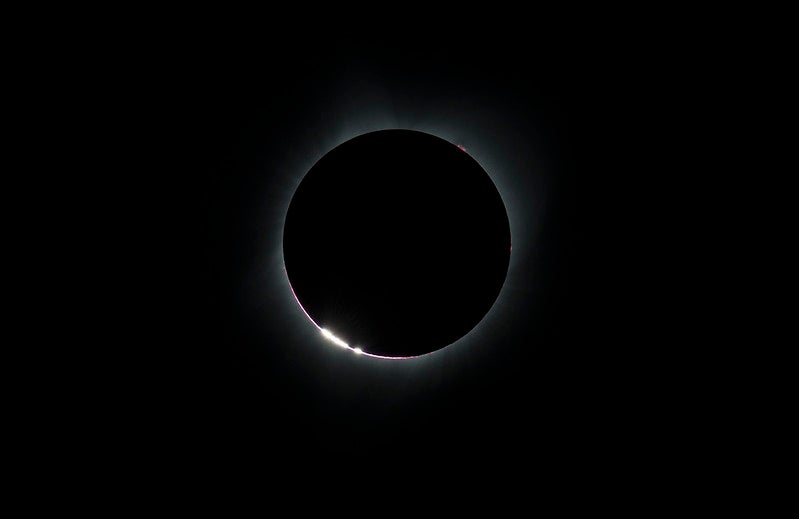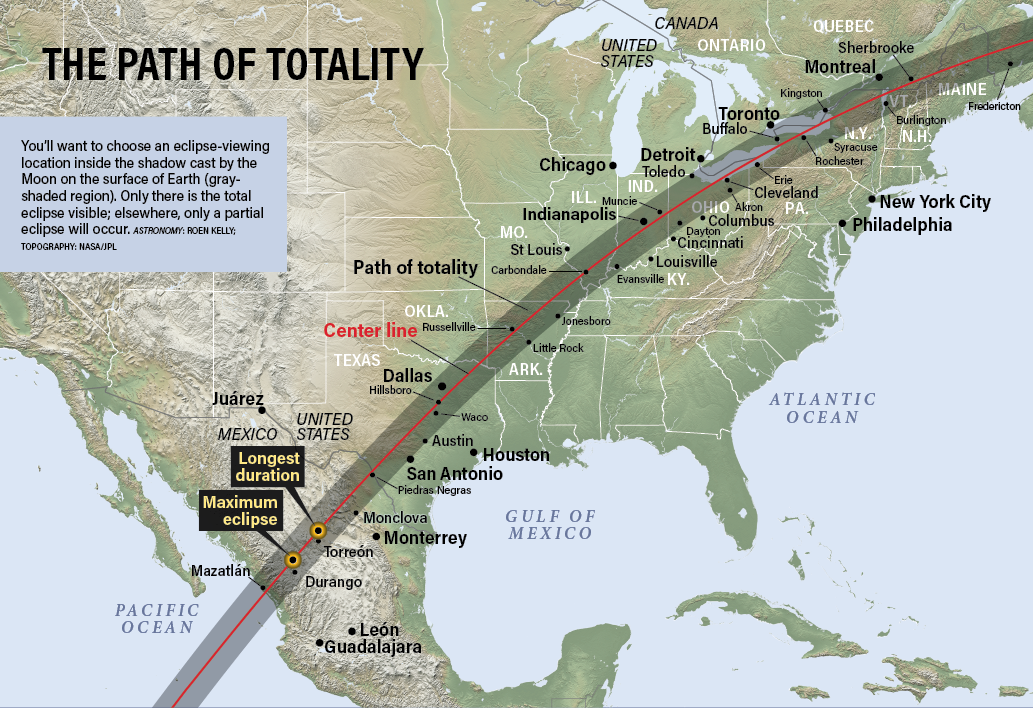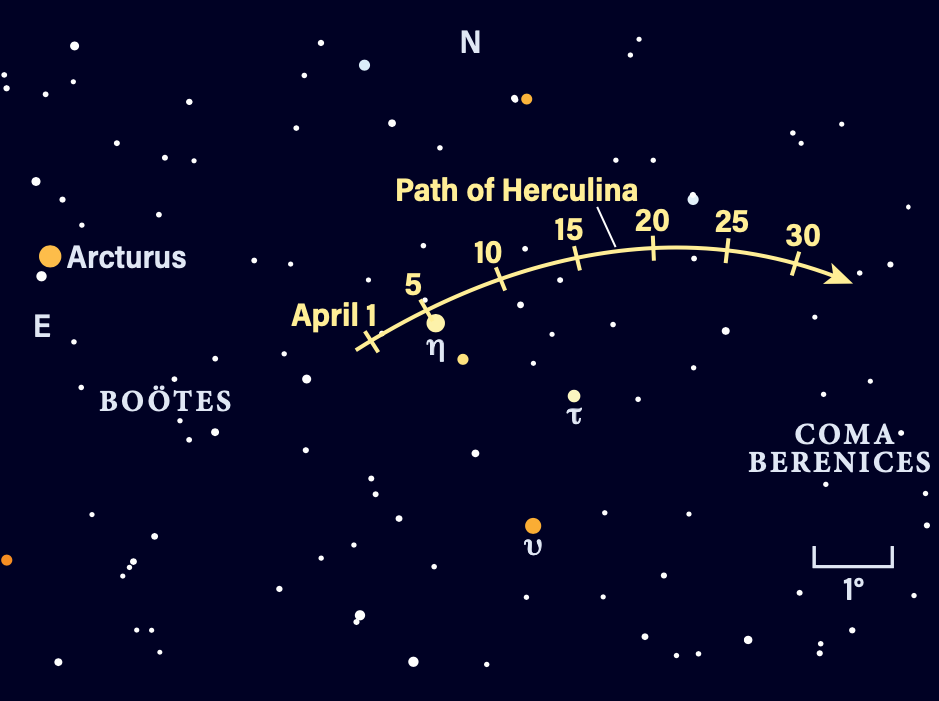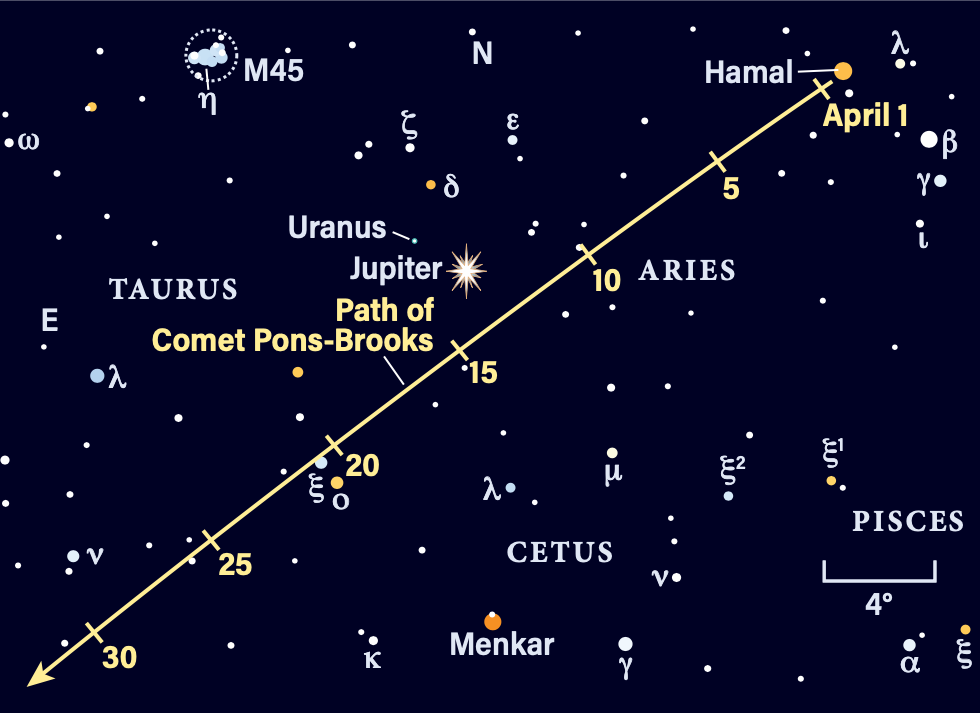
Friday, April 5
The Moon passes 2° south of Mars at midnight EDT, though neither is visible at that time. You can pick them up in the pre-dawn sky tomorrow, when our satellite has moved along the ecliptic and lies closer to Saturn.
The constellation Auriga is some 60° high in the west an hour after sunset and will slowly sink closer to the horizon in the coming hours. However, it’s a great early-evening target and Auriga is home to several deep-sky objects, including the three Messier open clusters M36, M37, and M38.
Let’s start with M37, which lies about 15° south-southeast of Auriga’s brightest star, magnitude 0.1 Capella. M37 glows at magnitude 6.2, just at the edge of naked-eye visibility, and so can be picked up with binoculars or any size telescope. This young grouping of stars is about 300 million years old and stretches roughly 24′ across. It is the richest of Auriga’s Messier clusters, with some 500 stars in total.
Next, move 3.7° northwest of M37 to land on magnitude 6.3 M36. Although roughly the same magnitude, this cluster is smaller (12′ across) and is only a fraction of M37’s age at 25 million years old. It’s a looser cluster but there are several bright stars in the center, with many fainter suns grouped around them. Astronomers believe M36 contains about 60 stars.
Finally, let’s hop 2.3° northwest of M36 to our final cluster, M38. This grouping is faintest at magnitude 7.4 and also appears much looser than the previous two; it spans about 21′ end to end. M38 is about 220 million years old and many observers think its brightest stars form a cross or even the Greek letter pi (π). Can you see either of these patterns in M38’s stars?
Sunrise: 6:36 A.M.
Sunset: 7:29 P.M.
Moonrise: 5:08 A.M.
Moonset: 3:54 P.M.
Moon Phase: Waning crescent (13%)
*Times for sunrise, sunset, moonrise, and moonset are given in local time from 40° N 90° W. The Moon’s illumination is given at 12 P.M. local time from the same location.
Saturday, April 6
The 27-day-old Moon now lies about 2° southeast of Saturn in the early-morning sky today. From an earthly point of view, the thin crescent Moon hangs below the planet, sitting between Saturn and the horizon as they rise in the east ahead of the Sun.
Look east about 20 minutes before sunrise and see if you can catch the pairing. First-magnitude Saturn may require binoculars or a telescope to pick out in the brightening sky, and the crescent Moon might require the same. The two are about 8° high at that time, with slightly fainter magnitude 1.2 Mars just to their upper right.
If you have a very clear eastern view, you might also spot magnitude –3.9 Venus just above the horizon some 20 minutes before the Sun. Do take care to stop using any optics at least several minutes before the Sun rises from your location, which may differ slightly from the times given below.
If you missed the opportunity to run this year’s Messier marathon last month due to weather or other circumstances, here’s your second chance, according to Lowell Observatory’s Tom Polakis. However, it’s not quite as ideal as the first and all 110 objects on the list may not be visible. Nonetheless, if you’re looking to train for the full marathon or simply do the best you can under the circumstances afforded you this year, give it a go! Contributing Editor Michael E. Bakich has provided a great list of Messier marathon targets as a roadmap you can follow.
Sunrise: 6:35 A.M.
Sunset: 7:30 P.M.
Moonrise: 5:36 A.M.
Moonset: 5:12 P.M.
Moon Phase: Waning crescent (6%)
Sunday, April 7
If you’re up Messier marathoning this morning, you won’t’ want to miss M15, a stunning globular cluster near the star Enif in Pegasus.
By about 4:30 A.M. local daylight time, the cluster stands 12° high and will continue climbing in the east. You can start your search with magnitude 2.4 Enif, which is often drawn to mark the nose of the Winged Horse. From Enif, it’s a short jump just 4.2° upward (northwest) to land on M15, which glows with a total magnitude of 6.2 and spans about 18′ on the sky.
This ball of ancient stars might be the densest of all the Milky Way’s globular clusters. Through your telescope, you’ll notice that the center appears almost uniformly lit, with the outer regions “dissolving” into individual stars. M15 packs all its 100,000-plus stars into a region of space just 175 light-years across, and this cluster is rich in unusual and interesting stars as well, including variables, pulsars, and even a planetary nebula.
Sunrise: 6:33 A.M.
Sunset: 7:31 P.M.
Moonrise: 6:02 A.M.
Moonset: 6:29 P.M.
Moon Phase: Waning crescent (2%)

Monday, April 8
Asteroid 532 Herculina reaches opposition at 8 A.M. EDT, though admittedly this event is about to be overshadowed. New Moon occurs at 2:21 P.M. EDT, putting the pieces into place for the much-anticipated total solar eclipse across North America. Another such event won’t touch the contiguous U.S. for two decades.
The eclipse track first touches land in Mexico, then travels from southwest to northeast, up through the U.S. starting in Texas and moving toward the eastern seaboard, as well as through parts of Canada, leaving land after passing over Newfoundland and Labrador. Many people along the center line will get more than four minutes of totality, twice that of the 2017 eclipse across America. And all across the U.S., even those who are not in the track of totality will see a partial eclipse.
The timing and duration of the eclipse will heavily depend on your location but occurs in the early afternoon for most. Astronomy.com has numerous guides on how to view the eclipse and when it will pass over you — visit www.astronomy.com/eclipse for everything you need to know, including a state-by-state guide and an eclipse simulator to show what you’ll see and when from any location.
With all the excitement, do remember that the only time it is safe to look at the Sun without protection is during those few fleeting moments of totality. During that time, you will need to remove your eclipse glasses or filters to see the eclipsed Sun and its corona. At all other times, however, you will need to wear eclipse glasses or correctly use an approved filter to ensure eye safety. That means during all other parts of the eclipse, you must take precautions to protect your eyesight. Check out Astronomy columnist Molly Wakeling’s piece on safe solar observing for more details and tips.
Sunrise: 6:32 A.M.
Sunset: 7:32 P.M.
Moonrise: 6:27 A.M.
Moonset: 7:47 P.M.
Moon Phase: New

Tuesday, April 9
Now that the excitement is over, let’s check out 532 Herculina tonight. The main-belt world is currently making a gentle arc through Boötes the Herdsman, not far from that constellation’s brightest star, Arcturus.
Let’s start at that star, which blazes at magnitude –0.1 from just under 40 light-years away. An hour after sunset, Arcturus is some 20° high in the east; the constellation will continue to rise throughout the evening. Once you’ve got your sights on Arcturus, swing your binoculars or telescope 5° west-southwest to magnitude 2.7 Eta (η) Boötis. From this star, it’s a very short hop to Herculina — the asteroid sits less than 1° northwest of Eta, having passed close to that star just a few days ago.
Herculina currently glows around 9th magnitude; despite its high number (532) it is one of the more massive objects in the main belt. Although astronomers once suspected it might have a moon, a satellite has never been physically spotted, even using the Hubble Space Telescope.
The asteroid will continue sailing through this region throughout the month. Early next week, it will be the brightest point of light in the field, so try coming back between the 15th and 17th for another look — you can use the star chart above to determine its location each night.
Sunrise: 6:30 A.M.
Sunset: 7:33 P.M.
Moonrise: 6:55 A.M.
Moonset: 9:06 P.M.
Moon Phase: Waxing crescent (1%)

Wednesday, April 10
This evening’s sky holds a spectacular scene, starting with a delicate waxing crescent Moon joining Jupiter and Uranus in Aries. The Moon passes 4° north of Jupiter at 5 P.M. EDT, then continues on to pass 4° north of Uranus at 8 P.M. EDT. Jupiter shines at magnitude –2, an unmissable evening star. Uranus lies less than 2° above (northeast) of the gas giant, and will require binoculars or a telescope to spot at magnitude 5.9. The Moon hangs above them both in the western sky, some 20° high half an hour after sunset.
But there’s more: As twilight falls, the glittering Pleiades star cluster (M45) in Taurus will appear above the trio in the sky. And now, with your binoculars or telescope, look just over 4° west of Jupiter to find Comet 12P/Pons-Brooks, the “infamous” Devil Comet that appeared in the sky near the eclipsed Sun just a few days ago. Despite the nearness of the Moon, our satellite’s young phase means its light shouldn’t interfere much with your view. Recently recorded at almost magnitude 4, the bright nucleus should be readily visible, with imagers picking up its green hue.
The fading light of day will make spotting the comet easier but the region is also setting, which by contrast adds a bit of challenge. Follow the scene as long as you can before the turbulence of the atmosphere near the horizon swallows the view.
Mars will pass 0.5° north of Saturn at 11 P.M. EDT — we’ll catch up with the two in the morning sky tomorrow.
Sunrise: 6:29 A.M.
Sunset: 7:34 P.M.
Moonrise: 7:25 A.M.
Moonset: 10:23 P.M.
Moon Phase: Waxing crescent (5%)
Thursday, April 11
This morning unfolds with Mars just 35′ north-northeast of Saturn. The pair rises around 5:15 A.M. local time, and by 6 A.M. most observers should have a good view, provided the horizon to your east is clear as the planets lead the Sun into the sky. By that time, they’re nearly 10° high, with magnitude 1.2 Mars just to the upper left of slightly brighter magnitude 1 Saturn. With the planets so close together, they can be readily seen in the same telescopic field of view.
Once you’ve got them in your sights, compare and contrast the two worlds. Saturn is larger, its disk spanning 16″ and its rings stretching to just over twice that. The planet’s stunning rings are tilted toward Earth at just 4°, appearing close to edge on. Their northern side is visible. The planet’s largest moon, Titan, sits just below the south pole. It will be difficult to pick out in twilight, so take your time and wait for moments of good seeing as the pair rises in the sky.
Mars, meanwhile, is just 5″ across. It should appear distinctly rust-colored, but any surface features will be difficult to make out. Because Mars is closer, it appears to move across the sky quickly, while Saturn stands nearly still. Tomorrow the two planets will stand side by side in the morning sky. The day after that, on the 13th, Mars will appear to Saturn’s lower left. The next few days are a great chance to watch solar system dynamics in action!
Mercury reaches inferior conjunction at 7 P.M. EDT; later this month it will reappear in the morning sky, so stay tuned.
Sunrise: 6:27 A.M.
Sunset: 7:35 P.M.
Moonrise: 8:01 A.M.
Moonset: 11:39 P.M.
Moon Phase: Waxing crescent (12%)
Friday, April 12
The large constellation Virgo sits above the eastern horizon after sunset this evening. The Maiden’s brightest star is Spica, which shines at magnitude 1. Although it is actually a binary pair, the two stars are too close to split and orbit each other in just 4 days. So, to the eye and with a telescope, Spica looks like a single bright luminary.
Not so for Porrima, also cataloged as Gamma (γ) Virginis and located 14.5° northwest of Spica. This 3rd-magnitude star can be readily split into its two components, now about 3″ apart. These two stars have a much longer orbit, taking nearly 170 years to circle once. Both have similar brightness and color, so some observers liken them to two cosmic headlights shining through the eyepiece from space.
Virgo is home to the huge Virgo cluster of galaxies, located in the northwestern portion of the constellation. Chief among those galaxies is 9th-magnitude M87, a giant elliptical that dominates the center of the cluster. This is the galaxy whose central supermassive black hole was the first black hole ever imaged. You can spot M87 for yourself by scanning about 7.3° northeast of 4th-magnitude Omicron (ο) Virginis.
Sunrise: 6:26 A.M.
Sunset: 7:36 P.M.
Moonrise: 8:44 A.M.
Moonset: —
Moon Phase: Waxing crescent (20%)

Sky This Week is brought to you in part by Celestron.









